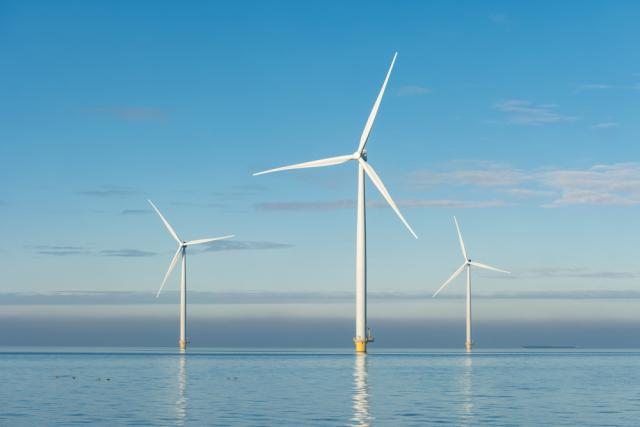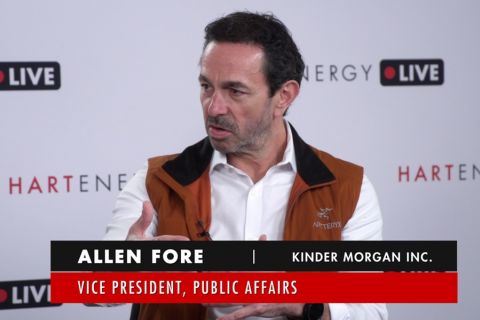
The Salamander Project has a proposed 100 megawatt (MW) pre-commercial size and will be a gateway for de-risking floating wind technologies for future commercial projects in Scotland. (Source: Shutterstock)
The Salamander Project, a joint venture between Ørsted, Simply Blue Group and Subsea7, was offered an exclusivity agreement as part of Crown Estate Scotland’s Innovation and Targeted Oil and Gas (INTOG) leasing round, the results of which were released by the Crown Estate Scotland on March 24.
Located on the east coast of Scotland, the Salamander Project has a proposed 100 megawatt (MW) pre-commercial size. The floating technology proposed for the project will allow turbines to be located in 100 m deep water, where traditional fixed bottom turbine foundations would be uneconomical.
According to an Ørsted press release, the Salamander Project will demonstrate commercial-scale technologies for roll out in utility-scale projects such as the ScotWind leases.
The project has a strong focus on supply chain development and will be a gateway for de-risking floating wind technologies for future commercial projects in Scotland, according to Salamander.
“This opportunity through INTOG will allow us to progress the project, which will play a significant role in how the industry delivers floating wind going forward and help the Scottish supply chain to ramp up activities for the local and international market,” said Huw Bell, Salamander Project director.
INTOG aims to attract investment in innovative offshore wind projects in Scottish waters, as well as to help decarbonize North Sea operations. It was broken up into two categories: IN, which were small-scale, innovative projects of less than 100 megawatts (MW); and TOG, projects connected directly to oil and gas infrastructure to provide electricity and reduce the carbon emissions associated with production.
INTOG offered exclusivity agreements to 13 out of 19 applications in this first round, five for IN and eight for TOG. Salamander was selected in the IN category. The other successful project applicants include Bluefloat Energy/Renantis Partnership, BP Alternative Energy Investments, ESB Asset Development U.K., Flotation Energy, Cerulean Winds, TotalEnergies and Harbour Energy. The projects have proposed capacities of up to 499 MW in the IN category and over 5 gigawatts (GW) in TOG.
The process was designed in response to demand from government and industry to help achieve the targets of the North Sea Transition Sector Deal through decarbonizing North Sea oil and gas operations. It also aims to further stimulate innovation in Scotland’s offshore wind sector, create additional supply chain opportunity, assist companies to enter the renewable energy market, and support net-zero ambitions.
Salamander is currently undergoing an environmental impact assessment submitted to Marine Scotland and Aberdeenshire Council, who have since passed it to statutory and non-statutory consultees. The project has a grid connection agreement with National Grid for project delivery by 2030 and to contribute to the U.K.’s 5-GW floating wind target.
Crown Estate Scotland expects option agreements to be offered in 2024.
Recommended Reading
US EPA Removes Existing Gas Plants From Proposed Carbon Rule
2024-02-29 - The U.S. Environmental Protection Agency will exclude existing natural gas power plants from its proposed carbon regulations that it plans to finalize in April.
US EPA Expected to Drop Hydrogen from Power Plant Rule, Sources Say
2024-04-22 - The move reflects skepticism within the U.S. government that the technology will develop quickly enough to become a significant tool to decarbonize the electricity industry.
The Jones Act: An Old Law on a Voyage to Nowhere
2024-04-12 - Keeping up with the Jones Act is a burden for the energy industry, but efforts to repeal the 104-year-old law may be dead in the water.
Kinder Morgan Exec: Building Pipelines ‘Challenging, but Manageable’
2024-04-05 - Allen Fore, vice president of public affairs for Kinder Morgan, said building anything, from a new road to an ice cream shop, can be tough but dealing with stakeholders up front can move projects along.
FERC Again Approves TC Energy Pipeline Expansion in Northwest US
2024-04-19 - The Federal Energy Regulatory Commission shot down opposition by environmental groups and states to stay TC Energy’s $75 million project.



